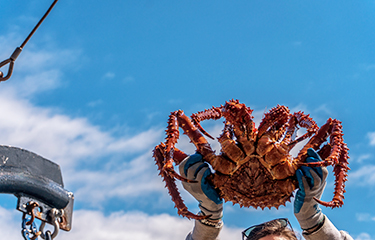The North Pacific Fishery Management Council is evaluating whether to institute fishing limits for all species in Alaska’s Red King Crab Savings Area.
In January 2023, NOAA shot down a petition from the Alaska Bering Sea Crabbers to close the 4,000-square-mile area west of Bristol Bay in the Eastern Bering Sea to all fishing gear types from January through June, citing a crash in the state’s red king crab population, which led to the cancelation off the 2022-2023 season.
NOAA said the ABSC’s petition did not meet the criteria for circumventing the normal regulatory process, which is run through the NPFMC advisory body.
At NPFMC’s June meeting in Sitka, Alaska, it considered two options for the savings area. The first would ban all trawl gear, as well as limiting or banning Pacific cod pot gear and hook-and-line gear. The second would instead close section 512, located in the southeast portion of Bristol Bay, to Pacific cod pot gear. The closures would be triggered if the state closed the red king crab fishery in the prior year or if a population survey showed a biomass lower than 50,000 metric tons, according to the Alaska Journal.
In the public comment period of the meeting, neither proposal received a positive response.
“The [savings area] was intended to be void of bottom contact by trawling to provide an area within the Bering Sea that was a refuge for king crab and their habitat,” ABSC Executive Director Jamie Goen said. “Closure of the [savings area and subarea] provides additional protections for conservation of the stock and consistent with the original intent of [savings area] management, which is to restrict mobile bottom contact by trawl gear in the closure area to protect crab and crab habitat.”
Alaska Seafood Cooperative Fisheries Science Director John Gauvin, representing multi-species trawlers fishing in the Bring Sea, Aleutian Islands, and Gulf of Alaska, said ASC vessels historically has recorded low amounts of bycatch.
“That area has been very important to our fleet, not so much in the recent past, but in years when the cap has been higher and the cod [total allowable catch] has been higher, we have conducted fisheries in that … area that, in my opinion, have been exactly what the council wants,” he said.
Bering Sea Pot Cod Cooperative Executive Director Craig Lowenberg warned a closure of the 512 area would have a negative impact on his fishermen.
“I’m concerned about the direction the council seems to be moving on restrictive regulations for our sector,” he said. “We’ve heard multiple times how static closures areas can be … problematic, yet they’re being seriously considered for our sector.”
The impact of trawling on Alaska’s crab populations has been a topic of major contention recently in Alaska, with crab and salmon fishermen arguing it has damaged their own fisheries, and that debate continued at the meeting. Pacific cod and sablefish fishermen using pot gear and hook and line and jig gear also have some level of crab bycatch.
For its next meeting in October 2023, the NPFMC asked its staff to revise the options presented at the June meeting to account for harvest levels in the proposed closure areas and provide more information about why the proposed trigger levels were chosen. Council members also asked for more information about the population levels of various commercial species in the proposed closure areas and about the crab bycatch totals of different gear types.
NPFMC Member Angel Drobnica said the issue will remain a top priority for the council.
“I think everyone here has a lot of concerns with the situation facing crab stocks and the impacts this has had on communities and stakeholders,” she said. “This has been a universal concern for a number of meetings, I think.”
Photo courtesy of shorex.koss/Shutterstock







